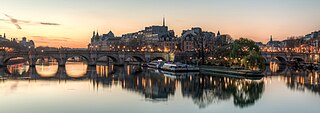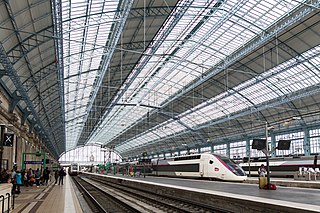History
In order to accommodate visitor traffic to the 1900 World's Fair across the Seine, the General Commissioner of the Exposition, Alfred Picard, approved the construction of a provisional footbridge opposite the Avenue Albert de Mun, to join the Army and Navy Halls to the exhibit recreating old Paris. Its architect, Jean Résal, also designed the Pont Alexandre III and the Viaduc d'Austerlitz.
The Debilly footbridge had, as well, a succession of provisional names. It was initially called passerelle de l'Exposition Militaire or passerelle de Magdebourg, only later passerelle Debilly, after General Jean Louis Debilly of the French First Empire who was killed in the Battle of Jena in 1806. The bridge became a permanent fixture from its original provisional status under the management of the City of Paris in 1906 after it was relocated opposite to the rue de la Manutention.
The footbridge is built on a metallic framework resting on two stone piers at the riverbanks, and decorated with dark green ceramic tiles arranged in a fashion that suggests the impression of waves. Along with the Eiffel Tower, this is the second metallic structure that stands as an attestation to the engineering achievements of its epoch. Nevertheless, in 1941, the Debilly footbridge was threatened with disappearance when the president of the architectural society characterized it as a forgotten accessory of a past event. As a contemporary of the Pont Alexandre III and the Austerlitz Viaduct, the Passerelle Debilly was eventually included in the supplementary registry of historical monuments in 1966.
The bridge was repainted in 1991 and its cladding resurfaced with hard tropical wood in 1997.
German diplomat
In 1989, a German diplomat working for the Secret Service of the Democratic Republic of Germany was found dead on this footbridge, several days after the Fall of the Berlin Wall. As it turned out, the footbridge was used as a secret gathering place for the secret service agents of East Germany during the Cold War. It is certainly one of the reasons that pushed Brian De Palma to shoot a scene of his thriller Femme Fatale on that footbridge in 2002.

The Exposition Universelle of 1900, better known in English as the 1900 Paris Exposition, was a world's fair held in Paris, France, from 14 April to 12 November 1900, to celebrate the achievements of the past century and to accelerate development into the next. It was the sixth of ten major expositions held in the city between 1855 and 1937. It was held at the esplanade of Les Invalides, the Champ de Mars, the Trocadéro and at the banks of the Seine between them, with an additional section in the Bois de Vincennes, and it was visited by more than fifty million people. Many international congresses and other events were held within the framework of the exposition, including the 1900 Summer Olympics.

Île de la Cité is an island in the river Seine in the center of Paris. In the 4th century, it was the site of the fortress of the Roman governor. In 508, Clovis I, the first King of the Franks, established his palace on the island. In the 12th century, it became an important religious center, the home of Notre-Dame cathedral, and the royal chapel of Sainte-Chapelle, as well as the city's first hospital, the Hôtel-Dieu. It is also the site of the city's oldest surviving bridge, the Pont Neuf.

The Pont des Arts or Passerelle des Arts is a pedestrian bridge in Paris which crosses the River Seine. It links the Institut de France and the central square of the Palais du Louvre,.

The Pont Alexandre III is a deck arch bridge that spans the Seine in Paris. It connects the Champs-Élysées quarter with those of the Invalides and Eiffel Tower. The bridge is widely regarded as the most ornate, extravagant bridge in the city. It has been classified as a French monument historique since 1975.

The American Church in Paris was the first American church established outside the United States. It traces its roots back to 1814, and the present church building - located at 65 Quai d'Orsay in the 7th arrondissement of Paris, France - dates to 1931.

Bordeaux-Saint-Jean or formerly Bordeaux-Midi is the main railway station in the French city of Bordeaux. It is the southern terminus of the Paris–Bordeaux railway, and the western terminus of the Chemins de fer du Midi main line from Toulouse. The station is the main railway interchange in Aquitaine and links Bordeaux to Paris, Sète, Toulouse Matabiau and Spain.
Dietmar Feichtinger is an Austrian architect established since 1989 in Paris.

The Pont de Bir-Hakeim, formerly the Pont de Passy, is an arch bridge that crosses the Seine in Paris. It connects the 15th and 16th arrondissement, passing through the Île aux Cygnes. The bridge, made of steel, was constructed between 1903 and 1905, in replacement of a footbridge that had been erected in 1878. The bridge has two levels: one for motor vehicles and pedestrians, the other being a viaduct built above the first one, through which passes Line 6 of the Paris Métro. The bridge is 237 metres (777 ft) long and 24.7 metres (81 ft) wide. The part crossing the Grand Bras of the Seine is slightly longer than the one crossing the Petit Bras.

The Pont de Sully is a bridge across the Seine in Paris, France.

The Île Louviers is a former island in the Seine in the centre of Paris, just upstream of the present Île Saint-Louis and of a similar size. Never built up, it was connected with the north bank of the river in 1843. Just before it ceased to be an island it had a surface area of 33,638m². In modern Paris the former island lies between the quai Henri IV and the boulevard Morland.

The Pont de l'Archevêché is a bridge crossing the Seine river in Paris, France.

The passerelle Léopold-Sédar-Senghor, formerly known as passerelle Solférino, is a footbridge over the River Seine in the 7th arrondissement of Paris. It is served by the Metro station Assemblée Nationale.

The Pont de la Concorde is an arch bridge across the Seine in Paris connecting the Quai des Tuileries at the Place de la Concorde and the Quai d'Orsay. It has formerly been known as the "Pont Louis XVI", "Pont de la Révolution", "Pont de la Concorde", "Pont Louis XVI" again during the Bourbon Restoration (1814); in 1830, its name was changed again to Pont de la Concorde, the name it has retained to this day. It is served by the Metro stations Assemblée nationale and Concorde.

The Passerelle Simone-de-Beauvoir is a bridge solely for pedestrians and cyclists across the Seine River in Paris. It is the 37th bridge on the Seine in Paris. It is located between the bridges of Pont de Bercy and Pont de Tolbiac and links up the 12th and 13th arrondissements of Paris. Its nearest Paris Metro station is Quai de la Gare.

The Bassin de la Villette is the largest artificial lake in Paris. It was filled with water on 2 December 1808. Located in the 19th arrondissement of the capital, it links the Canal de l'Ourcq to the Canal Saint-Martin, and it represents one of the elements of the Réseau des Canaux Parisiens, a public-works authority operated by the city. The other components of the network are the Canal de l'Ourcq, the Canal Saint-Denis, the Canal Saint-Martin, and the Bassin de l'Arsenal. Together, these canals and basins extend roughly 130 kilometres (81 mi).

Jean Résal was a French civil engineer. He was a professor of mechanical engineering at the École polytechnique, and designed several metal bridges in France, especially bridges above the Seine in Paris:

The Quai des Tuileries is a quay on the Right Bank of the River Seine in Paris, France, along the stretch close to where the Palais du Louvre and the Quai François Mitterrand is situated, in the 1st arrondissement.

The architecture of Paris created during the Belle Époque, between 1871 and the beginning of the First World War in 1914, was notable for its variety of different styles, from neo-Byzantine and neo-Gothic to classicism, Art Nouveau and Art Deco. It was also known for its lavish decoration and its imaginative use of both new and traditional materials, including iron, plate glass, colored tile and reinforced concrete. Notable buildings and structures of the period include the Eiffel Tower, the Grand Palais, the Théâtre des Champs-Élysées, the Gare de Lyon, the Bon Marché department store, and the entries of the stations of the Paris Metro designed by Hector Guimard.

























